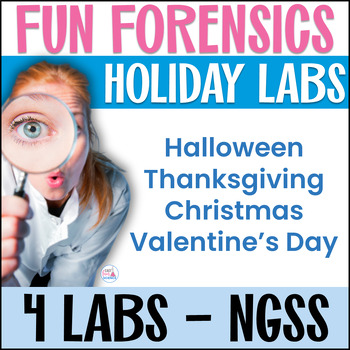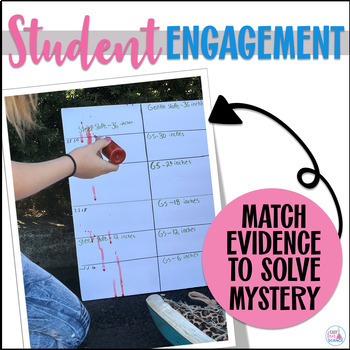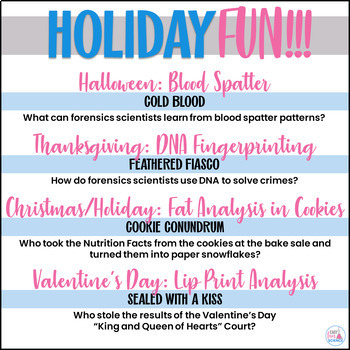Forensic Science Crime Scene Investigation Holiday Activities - Valentine's Day
- Zip
Products in this Bundle (4)
Also included in
- Students LOVE the intrigue of CRIME SCENE INVESTIGATION! This 8-pack of Forensic Science Lesson Plans is the perfect addition to your curriculum, created for upper elementary and middle school students. They will love these not-scary mock crime scene activities! These CSI activities are easy to setPrice $22.00Original Price $32.00Save $10.00
Description
Are you looking for fun, yet educational, way to celebrate holidays without sacrificing instruction time? Look no further! This collection of forensic science crime scene investigation (CSI) activities includes 4 engaging laboratory activities that infuse the excitement of holidays with the intrigue of forensic science. Each activity is specifically designed for grades 5th through 10th and provides a unique opportunity for students to apply forensic science techniques in a fun and festive way.
Included Activities:
- Cookie Conundrum: Forensic Science Christmas Activity with Fat Analysis
- Cold Blood: Forensic Science Blood Spatter Halloween CSI Activity
- Feathered Fiasco: Thanksgiving DNA Extraction and Fingerprinting Gel Electrophoresis
- Sealed with a Kiss: Using Lip Prints to Solve a Valentine's Day Mystery
Cold Blood: Forensic Science Blood Spatter Halloween CSI Activity
Are you looking for a fun and engaging science activity for Halloween? Introduce your students to blood spatter analysis in forensics and how investigators use blood droplets in forensics to solve crimes. You will definitely want to add this not-so-scary, hands-on experiment to your list of mock crime scene investigations (CSI) activities.
Your upper elementary or middle school students will love this mock crime scene classroom activity! This activity was designed for my homeschool co-op, but it can be used without any traditional classroom without modifications. This is a great alternative to graphic or scary CSI activities. This lab is easy to set up with common materials you can easily find at your local grocery store. Tested and approved by my students - this is a FUN activity that your students will love!
The Story:
Max, the Johnson's dog, frequently escaped to explore the haunted history of Hollow Street and returned with eerie souvenirs. One evening, their daughter Ana discovered a blood-streaked newspaper Max brought, causing panic until her brother Carter confessed it was a fake mix for his Halloween prop. Inspired, Ana used the newspaper as a prop for a ghostly tale for her drama club's performance.
What will students do?
- Learn the basic principles of blood spatter analysis in forensic science
- Develop and articulate predictions
- Conduct controlled experiments, adjusting variables like angle and height to determine their effects on blood spatter patterns
- Accurately measure blood spatter dimensions, analyze their data, and draw conclusions based on their findings
- Demonstrate the ability to represent their experimental results visually using graphs, ensuring they select appropriate graph types, axes, and scales for their data
- Interpret their experimental findings, comparing their results to initial hypotheses and drawing logical conclusions based on evidence
- Creatively apply their understanding of blood spatter analysis to construct a fictional narrative, showcasing their ability to use scientific information in an imaginative context.
4 Activities Included:
- Activity 1: Blood Spatter Patterns - Students will drop fake blood from various heights and angles to create different sizes and shapes of blood droplets
- Activity 2: Blood Spatter Data Collection - Students will measure the length and width of blood spatters in a table
- Activity 3: Blood Spatter Data Analysis - Students will use data that was collected to construct two line graphs, showing the relationships between angle, height and size of blood droplets
- Activity 4: Constructing Mock Crime Evidence and Stories - Students will create mock evidence using fake blood droplets and blood spatter patterns. Then, they will create a story to go with their evidence and present it to their class.
Cookie Conundrum: Forensic Science Christmas Activity with Fat Analysis
Looking for a FUN Forensic Science Christmas Activity? This public-school, low-prep activity is EASY to set up and FUN for students! Students will use brown paper bags to investigate the fat content of cookies. This information will be used to solve a holiday mystery. Then, students will examine motives for each suspect in the mystery and write a short article. Your students will love this Holiday-themed, engaging FUN FORENSICS activity... NO ONE DIES! This activity aligns with Next Generation Science Standards (NGSS) and is perfect for integrating STEM into your Holiday-themed lessons.
The Story:
Help! Just before the Holiday Cookie Contest is about to begin, volunteers realize that a prankster took the Nutrition Facts labels and used them to make paper snowflakes! They need your help to quickly identify which label goes with which cookie….
Activity 1:
Analyze fat content of cookies and then match labels to cookies.
Activity 2:
Examine the motives of suspects and write a short newspaper article to share the details.
What's Included in this Forensic Science Christmas Activity:
- Detailed Student Instructions: Detailed step-by-step instructions with photos (printer-friendly version also included) and data tables are included.
- Comprehensive Teacher's Instructions: Includes setup instructions, prep, and an answer key.
- Three Informational Reading Passages: Detailed and student-friendly texts that provide background knowledge on forensic biochemistry, examining motives, and an article about the Horse Meat Scandal.
- Mock Crime Scene Scenario: A fun and intriguing Holiday mystery centered in the town of Pineville, at an annual holiday cookie contest.
- Hands-On Fat Analysis: Step-by-step instructions for students to conduct their own analysis of the fat content of cookies using the "brown paper bag test."
- Assessment Tools: Follow-up questions to assess students' understanding of the material.
- Creative Writing Prompt: An opportunity for students to write their own ending to the mystery, fostering creative thinking and writing skills.
- Editable Nutrition Facts: Easy-to-use, editable Nutrition Facts labels for you to modify the labels for whichever cookies you choose to use in the activity.*
Educational Value:
- Promotes Critical Thinking: Students analyze evidence and deduce the culprit, developing important critical thinking skills.
- Real-World Science Application: Demonstrates the practical application of forensic biochemistry in solving crimes.
- Interactive Learning: Encourages active participation and hands-on experience with scientific concepts.
- Cross-Disciplinary: Incorporates elements of biology and language arts.
*IMPORTANT NOTE TO BUYERS!!!
This activity was written using cookies from Panera Bread. You can purchase cookies from Panera Bread and use the prepared labels included in the activity. Or, you can use any cookies of your choosing. Results will be best if you purchase cookies from a bakery or if you bake the cookies using store-bought cookie dough, as opposed to baking "homemade" cookies.
Note:
- You must have access to the nutrition facts for each cookie for this activity to work well.
- Choose cookies with different fat content so the students can attempt to match their results with the nutrition facts.
Feathered Fiasco: Thanksgiving DNA Extraction and Fingerprinting Gel Electrophoresis
Who stole Mr. Gobbles, the famous Thanksgiving parade turkey? Students will extract DNA from strawberries to learn about DNA extraction. Then, they will run paper "DNA" evidence through a simulated gel electrophoresis chamber to make a DNA fingerprint. Your students will love this Thanksgiving-themed, engaging FUN FORENSICS activity! Feathered Fiasco is a comprehensive classroom resource designed to introduce middle school and high school students to the exciting world of forensic science and DNA analysis. This activity aligns with Next Generation Science Standards (NGSS) and is perfect for integrating STEM into your Thanksgiving-themed lessons.
The Story:
In the peaceful town of Gobbler's Grove, the beloved turkey Mr. Gobbles, famous for his extraordinary feathers, was the pride of the annual Thanksgiving parade. But this year, just before the festivities, Mr. Gobbles disappeared!
Activity 1: DNA Extraction of a Strawberry:
Students will use a simple technique with easy-to-find materials to extract DNA from fresh strawberries.
Activity 2: Gel Electrophoresis Simulation:
In this part of the activity, students will be given five paper strands that represent DNA. The first strand is from the victim’s (Mr. Gobbles) feathers. The other four strands were collected from the suspects. Their job is to color each strand of DNA and then cut the strands with scissors at the same location a restriction enzyme would make a cut. They will arrange the fragments in order of size, from smallest to largest on an image representing an electrophoresis gel. Then they will compare the cut pieces of DNA from Mr. Gobbles' feathers to the pieces from the suspects to see if they can find a match.
*Activities 1 and 2 can be used separately as stand-alone activities or together for an extended activity.
What's Included in this Thanksgiving Science Gel Electrophoresis Simulation:
- Three Informational Reading Passages: Detailed and student-friendly texts that provide background knowledge on DNA, DNA fingerprinting, and gel electrophoresis.
- Mock Crime Scene Scenario: A fun and intriguing Thanksgiving mystery involving the beloved turkey Mr. Gobbles, complete with suspect profiles and a narrative to engage students.
- Hands-On DNA Extraction: Step-by-step instructions for students to conduct their own DNA extraction from strawberries, illustrating the real techniques used in labs.
- DNA Fingerprinting Simulation: A paper-based simulation activity where students cut and arrange DNA strands to solve the crime using the principles of gel electrophoresis.
- Comprehensive Teacher's Instructions: Includes setup instructions, prep, and an answer key.
- Assessment Tools: Follow-up questions to assess students' understanding of the material.
- Creative Writing Prompt: An opportunity for students to write their own ending to the mystery, fostering creative thinking and writing skills.
- Printable Materials: All necessary printable resources, including DNA strands for the simulation.
Sealed with a Kiss: Using Lip Prints to solve a Valentine's Day Mystery
Your students will love this Valentine's Day Forensic Science Crime Scene Investigation (CSI) activity that uses LIP PRINTS to solve a mystery! This activity is a perfect way to celebrate Valentine's Day without sacrificing valuable instructional time. This activity is low-prep, NGSS-aligned and fun for kids! AND.... Unlike other forensics activities, this lab will not give your students nightmares! In Fun Forensics activities, no one dies!!!
Here is the scenario:
Every February, Heartfield Middle School holds its annual Valentine’s Day dance. The principal, Mr. Stevens, holds an event crowning the Middle School “King and Queen of Hearts.”
On the night of the dance, the gym buzzed with anticipation. It was time for the students to find out who would be crowned as the King and Queen of Hearts this year. The music slowed and the lights in the gymnasium were turned on as Mr. Stevens was to reveal the lucky students.
As Mr. Stevens opened the red, glittery envelope, he gasped. The paper with the names of the winning students was missing!! The only thing in the box was a piece of paper with bright red lip prints.
What will students do in the Crime Scene Investigation?
- Learn how scientists use lip print analysis to solve crimes
- Collect and analyze their own lip prints
- Examine mock crime scene evidence
- Solve a Valentine's Day forensic science mystery
What will students learn?
- Students will learn about the role of forensic science in criminal investigations, with a focus on how unique physical characteristics, like lip prints, are used for identification.
- Students will understand that each individual has unique biological features, such as lip prints, similar to fingerprints, and how these features can be used in identifying individuals.
- Students will enhance their ability to observe detailed patterns and differences in lip prints, which is a critical skill in forensic science.
- Students will gain experience in collecting data by creating lip prints, and then analyzing these prints to identify distinct patterns and characteristics.
- Through analyzing lip prints and comparing them to solve a mock crime, students will enhance their critical thinking and problem-solving abilities.
- By participating in a mock investigation, students will see the application of scientific concepts in real-world scenarios, enhancing their understanding of the relevance of science in everyday life.
This product includes the following:
- FUN mysterious story to set the scene
- Background information for teaching
- Lists of materials
- Preparation instructions
- Three student articles
Lip Print Pattern Diagram - Lip Shapes Diagram
- Student instructions
- Lab report with spaces
- Follow-up questions and answer key
This activity supports the following NGSS:
- MS-LS1-3
- MS-LS1-5
Looking for more Fun Forensics activities? Check out...
- Forensic Science Urinalysis Crime Scene Investigation
- Forensic Science Chromatography Crime Scene Investigation (CSI) Activity
- Mystery Powders Forensic Science Crime Scene Investigation (CSI) Activity
- Forensic Science Fingerprinting Crime Scene Investigation (CSI) Activity
FUN FORENSICS BUNDLE:
Don't forget to FOLLOW ME - all new products are 50% off for the first 24 hours. You will get only notifications of new products by following me here.
Would you like FREE Science Resources? Head over to my website and sign up for my weekly newsletter, full of freebies, science tips and updates. EasyFunScience.com
Not finding what you are looking for? I am happy to take requests for the resources you are looking for. Simply go to the "Ask a Question" on my store page to contact me directly.
You can also find me on Instagram at Easy.Fun.Science






